|
Thanks for filling in Group Crit – FMP
|
||||||||||||||
|
Here’s what we’ve received from you:
|
||||||||||||||
Group Crit – FMPPair up with someone, and complete this form. YOU WILL NEED the ‘Exemplification matrix’ document open, you can find this by clicking ‘OPEN” next to ‘END OF YEAR PROJECT’ and scrolling down.
What is the E-mail address of the person you are feeding back to? You will need to send them a copy of these responses after completion. *
How much practical work has been completed so far? Give some feedback on their current practical progress. *
The film is finished to a high standard
How many RESEARCH posts have they completed so far? *
Choose 1 RESEARCH post, read through it, write some positive feedback using the ‘research’ section of the EXEMPLIFICATION MATRIX *
There was a good amount of information in the post detailing the floor plans of the theatre he was originally going to film in. Good use of images.
Choose 1 RESEARCH post, read through it, write about how they could improve this post using the ‘research’ section of the EXEMPLIFICATION MATRIX *
Could have had a little more information, and some personal opinions would have been nice to see.
How many BLOG THE WEEK posts have they completed? *
Choose 1 BLOG THE WEEK post, read through it, write some positive feedback using the ‘problem solving’ and/or ‘evaluation’ sections of the EXEMPLIFICATION MATRIX *
A good example of explaining what they did that week, and good detailing of what they achieved that week.
Choose 1 BLOG THE WEEK post, read through it, write some things to improve using the ‘problem solving’ and/or ‘evaluation’ sections of the EXEMPLIFICATION MATRIX *
Again, could have had more personal opinions.
Have they included evidence of their experiments and things that they have learned? What feedback can you give them on this? *
Yes they have, they have a good use of images so everything is very clear what they are talking about, but some personal opinions, and analysis could be there.
Do you think they have done enough work? Consider the length of the project (2-3 months). *
What would you like to see more of? *
Personal opinions, what he thinks.
Overall, what grade would you currently award them? Why? *
Distinction
|
FMP Evaluation
For my proposal I stated that I wanted to create an anthology of three or four of my favourite poems. I stated that I would take my own interpretation of the meaning of the poems and create three or four short films corresponding with the poems. These films would be inspired by works such as video art, and other films such as The Grand Budapest Hotel (dir. Wes Anderson), and Victoria (dir. Sebastian Schipper). Personally, I think that I have achieved the majority of what I had to do. It’s true that I created films based on poems (in particular City Dusk by F. Scott Fitzgerald, and Do Not Stand At My Grave And Weep by Mary Elizabeth Frye) that took my own interpretation and translated the written works on screen, and they were inspired both in mise-en-scene and cinematography by existing films (The Way He Looks (dir. Daniel Ribeiro) and Victoria (dir. Sebastian Schipper).
The only difference to the proposal is the fact that I didn’t create three to four films, only two. I was originally aiming for the whole four, and I had four poems in mind (the other two being The Trembling of the Veil by Allen Ginsberg, and Heart To Heart by Rita Dove). I completed all the relevant research for both of these poems, the same as I did for the two that I used in my FMP, however, I set myself too much work for the time limit, and was concerned about overworking myself, so I cut the amount of poems down to two. I was concerned that forcing myself to complete, essentially, four short films, would cause the quality of these films to suffer, and I was more concerned about quality over quantity. If I were to go back, and for future projects, I will definitely be more conscious about having less complicated ideas and setting myself an amount of work that I know I can complete. I’d rather have an idea I can work on without worry of overworking myself and creating something lower in quality than I’m satisfied with, and then building on that idea when there is more time to spare, to have a really polished production.
In this project, I have learnt that creating (filming, conceptualising, editing etc.) a larger production is very tiring. At first, I think I wasn’t too fussed, because in class we’d done projects which required us creating our own projects individually (the filmic journey project, for example) and I didn’t realise how much these smaller projects would differ from a much larger project. Having to complete a series of research posts was both interesting and tiring, as well as having to take on several roles that would be taken by different individuals in an actual film production. One place where I felt I was lacking was communicating with my peers and classmates, and asking for help. I’m quite a shy person by nature, and that definitely did me no favours in this project. I think I was more concerned with not impeding on their projects, that I made myself take on all of the work myself that other people would have gladly helped with. For example, at my filming date, I took on all camera duties myself, which led to some precarious situations – such as having to hold both the camera in a figrig, and my iPhone torch that I was using as a makeshift lighting apparatus because there were no lights in the resource centre available to be booked out. Looking back on my project, it was in these moments during my filming date that I wished I had someone else on the course there to help me with filming. In the reality of full scale film and TV productions, there are multiple camera operators and assistants, and although this wasn’t a full scale film production, I wish I had had someone there. I could have asked my friends who were acting in my film to help, which I did at times ask to help move or hold my iPhone torch for lighting assistance, but they are less experienced in camera work because they’re not doing a creative media course like I am, so having someone who was on the course with me to help would have been better. For the next project, I’ll definitely have to remember to be a bit bolder in asking for help when I really need it, and not feeling guilty for asking, and knowing that these people will be happy to help, and in turn helping them in return.
Another issue I battled on this project, was time management. As I mentioned before, as the time progressed in my project, I found it harder and harder to believe in my ability to shoot all four films for all four poems. I also was battling with my own dissatisfaction for the footage I had shot for the fourth poem I was going to use, which was Heart To Heart by Rita Dove. I had already done a reshoot, because the footage I had initially shot I thought was lacking in quality, and I didn’t like the colours or composition of the shots, so I had reshot, taking it in a completely different direction, with a completely different idea. However, after reviewing my footage for the reshoot, I again found that I wasn’t satisfied with what I had shot. I think this was largely because I didn’t have a firm enough idea of what I wanted to do for this poem’s film. For the other three films I had very strong concepts of what I wanted to do, and I could easily picture in my head what I wanted the films to look like. However, I really struggled to come across a strong enough idea for the fourth film for Heart To Heart. I think I had forced myself to decide to do the poem to fill my preconceived quota of four films for four poems. However, I felt very dissatisfied, and that impacted how much motivation I had to polish my other films, so it was causing my other films to suffer. I think that I was reluctant to let go of the idea that I could create four films, because I knew that I had put it in my proposal, and I didn’t want it to seem like I was lacking, only doing two films instead of four. For the next project, I definitely now realise that changing your ideas, for whatever reason, whether that be mental or physical health, time constraints, or lack of resources, perfectly fine. It’s better to have a very short film where the quality is excellent, than a longer film where the quality suffers because of how much work you had to accomplish. In the broader sense of the film industry, ideas are changed all the time, and it’s devastating for a production company to put lots of money into an aspect of the film, and to have that aspect fail and have to change, loosing them lots of money. For example, just recently Ghostbusters actor Dan Aykroyd criticised director Paul Feig for going way over budget, saying that the production company told him to cut back on costs, but he didn’t listen and ended up staging expensive reshoots which cost $40 million – just for reshoots. Although Sony has backed Feig, Aykroyd vented his frustration, and claimed this was likely the reason the film wasn’t likely to get a sequel, as it hadn’t made back double it’s budget (which is the standard in Hollywood for a good prophet), as it was supposed to have. This makes me feel slightly better about changing my ideas, because if big studios in Hollywood can do it and, for the most part, pull through, so can I.
For this film, I researched a total of nine films, four for music inspiration, two for costume inspiration, and three for cinematography inspiration. For music inspiration I used the films Moonlight (dir. Barry Jenkins), Harry Potter & The Half Blood Prince (dir. David Yates), Kill Your Darlings (dir. John Krokidas), and Victoria (dir. Sebastian Schipper). Music in film and television has always been an interest of mine. Music has been one of my favourite subjects in school, and for a while I thought I would take my career in that direction, studying music in university and eventually becoming a composer for film, television, and video games. I originally wanted to compose the music myself, but found that I didn’t have time to compose four separate tracks, and decided to opt for using royalty free music instead. The research into the soundtracks of these four films really helped me with my project, because I could use them to isolate what instruments I wanted to hear in the music for my project, as well as the tone and atmosphere of the music. Eventually, I think I ended up choosing music that really fit the themes of the poems I was using for my final production, and that was helped by the research I had done.
For costume inspiration I used the films Picnic At Hanging Rock (dir. Peter Weir), and Breathe (dir. Melanie Laurent). I studied the costumes of each of these films and how they corresponded with the film’s tone and story. Then using these as inspiration, I chose my own costumes that I felt would fit with the theme of my films.
For cinematography and mise-en-scene inspiration, I used the films Victoria (dir. Sebastian Schipper), The Grand Budapest Hotel (Wes Anderson), and The Way He Looks (dir. Daniel Ribeiro). In these research posts, I analysed the cinematography of several of my favourite shots of the film. I really enjoy analysing cinematography, so I enjoyed writing these posts quite a lot, as I love to pick apart a shot and try to figure out what a director was trying to portray through aspects such as composition, costume design, facial expressions & body language, colours, and space & lines. After analysing these shots, I then applied the knowledge I had learned from them, and wrote about how I could use these aspects and components in my own film. Overall, it was a very useful experience because I learnt a lot more about things like shot composition, where to place actors, and how to portray a significant idea or emotion through a film shot.
Overall, although there are definitely things that I would revise and change about this project if I had the chance, I’m very happy with how it all turned out. Honestly, there were points during this project where I was worried that I wouldn’t be able to finish all that was required, let alone to a high enough standard, so I’m very happy that I completed everything and I’m on the most part very proud and satisfied with my end production.
Blog The Week 6
05/06/2017 – 09/06/2017
Monday
Today I came into college with one primary focus on my mind: editing. I knew that I had to edit my film together this week, and I knew that it would make me feel so much less stressed because then I would have my film completed and all left to focus on a few blog posts that needed to be written and finished. I was originally planning to do all the editing over the course of the two and a half days, because I don’t have Premiere Pro software at home (only iMovie, which is fine for little projects, but a nightmare for more serious work where everything needs to be very polished). However, I found out that the college would be closed Tuesday morning because of GCSE exams. This wasn’t so much an annoyance as a kick up the backside, as now I knew I needed to be quick and edit my film in one college day. Although the college would be open Tuesday afternoon, and there is also Wednesday, I didn’t want to leave my editing that late because doing it earlier means that I get it out the way and have time to polish up the rough edges of my project elsewhere, like in my blog posts for example. Luckily, I quite enjoy editing and I’m fairly quick at it, so I managed to get stuck in and finish it in good time, and still have time to write a few blog posts. However, editing for the whole day can be quite grueling so if anything I had a greater respect now for professional editors who do this day in and day out with a lot longer and more serious projects than mine.
I started editing the audio first. I knew I would be working in lines, corresponding the correct shot with the correct line of the poem, so I cut the poem into singular lines and labeled them with what line they were so I wouldn’t forget which was which. Then I used my shot list to define which shot went where and started to edit the clips together. Originally, I put an equal amount of space between each line of the poem, but I quickly found that this wasn’t exactly convenient because some shots were either too short, or would seem too dragged out. After putting all the clips together, I watched through to see where I could improve, every so often pausing to either extend a clip I felt was too short, or clip one too long. I was debating by this time whether to put a title and credits sequence at the start and the end of the clip, but I decided I would. I overlaid the titles over the footage because I thought that the transition from title to film would be more seamless that way. As for the credits, I was originally debating whether I should put a singular credits after each poem, or just do both credit sequences at the end, but I decided that I would a credits sequence at the end of each poem, as if they were two completely separate films edited together. Again, I overlaid this over the last shot, but on the last poem (City Dusk) I decided to let it carry on after the footage had finished for a few seconds and continued to let the music play over it, because I thought it would be a clearer indication that the film was ending, and not just transferring to another poem again.
The font I used was Arial, because it’s a simple sleek and easy to read font. I used the colour white, because it enabled the credits and titles to be readable against the darker colours of the shot. In the credits, I listed who the poem was by, and who was starring in the film, myself of course, and who the music was by and what the song was called. I decided to put the voice overs under ‘starring’ instead of under their own voiceover categories for space and font size purposes.
After creating the titles and credits, I went back through all the footage and colour grading. For my Do Not Stand At My Grave And Weep film, I used the Fuji Eterna 250d Kodak 2395 colour grading preset on all the shots except one, the footage with the flickering lights, where I used Cinespace 50 Faded Film. I used Fuji because it kept a subdued look while making the colours ever so slightly more vibrant so as not to keep the original slightly washed out DSLR look. I used Cinespace because I needed the shot to be brighter because I had filmed it on my iPhone and it was a little too dark compared to the other shots.
For the City Dusk film, I used the same Fuji Eterna colour grading preset for the same reasons, and for the darker shots (of which there was quite a few because I was filming in the dark in my back garden with only my iPhone torch providing light) I brightened them using the brightness and contrast effect tool, brightening them to 50.0 and keeping the contrast the same. This gave the shots quite a faded look, which I actually quite liked for this film, because it kept the original tone of young freedom and made it seem more handheld movie like, which I liked.
After colour grading, I moved on to the music and audio. I increased the audio of the poetry voice over to 6.0 decibels higher than normal, which is the highest it can go, because I didn’t want to risk the voiceovers being drowned out by the background music and inaudible. Luckily, however, this wasn’t the case. For Do Not Stand At My Grave And Weep, I decided to choose the song The Curious Roe by Axletree, and for City Dusk I chose the song Passages by Kai Engel. You can find more information on why I chose these songs on these two blog posts regarding the music of each film 1/2.
Then all I had to do was export and I was finished! I’m very happy with my end product, and although there were things that I would change and improve on if I were to do the same again, I’m still happy with my end result because I think it looks polished and interesting, and also bears a similarity to the video art I studied for my research posts which is what I was aiming for. You can find the post containing the finished production here.
Tuesday
As the deadline of our FMP for year one was approaching, and I had finished working on the actual film, now all I needed to do to finish my project was to complete a few blog posts, and polish a few edges of the project and I was done! I spent the day going meticulously through my blog posts to check for any spelling and grammar errors (because I know English skills are marked for this project, and also because I wanted to be as clear about what I was trying to get across as possible), and making sure I had the right links where they were supposed to be, and I had written everything I needed to. This task was a little tedious, because I had to read everything I’d written this whole project which proved to be quite a bit, but is very important for a polished, and professional level project.
Wednesday
Today I wrote an evaluation post for my work. Evaluation is a very important part of any project because it’s a time to reflect on our own work and the parts we like and went well and the parts that we would improve. My evaluation can be found here. This went hand in hand with the group crit, where we took a look at the work of one of our classmates and did a short survey reviewing their work – what they did well on and what they could improve on. I reviewed Drew Graves’ work. Group crits are also important because it gives us a chance to see the standard of work that our peers are working at, and can help us improve our own work by noticing things that they achieved that we might have missed. My group crit survey can be found here.
Thursday
N/A
Friday
N/A
Poetry in Motion – Final Production
Filming Diary – 05/05/2017
On Friday 5th I did my first batch of filming. Originally I wanted to get all of my filming done in one weekend, and had planned for a second filming date on Sunday 7th. However, I quickly realised that shooting, essentially, four short films in one weekend was far too ambitious, so I decided I would cancel the Sunday filming date. Obviously, in the real business of film, this would be very disrespectful to all the people I’d hired for production who would be expecting work and a paycheck for their services. If I were a real director/producer, I would have to suck it up and do the Sunday filming regardless, since I’d planned it. But thankfully, I’m not a real director so calling off a few friends who hadn’t had plans regardless wasn’t a huge deal.
I knew that on Friday I would need to get a lot done. Filming was to commence at 17:00 (though some complications caused it to occur at more like 17:30) and I needed to film three out of the four poems that I was using for my final piece. I was also anxious because two of these poems required daylight and although it gets darker later in the summer, I still didn’t want to risk loosing daylight and missing the opportunity to film.
The first poem I filmed was Heart to Heart by Rita Dove. For this one, I decided to take a slightly different approach. In all of my other films, I would be using actors and nameless characters, but for this one I wanted to use objects. This poem is about the poet’s heart, and there’s a lot of symbolism within the poem. I used several objects, including an apple, tealight candles, a hammer, and many more.
I wanted the camera to remain stationary throughout the whole piece, so a tripod was a must. I already own a tripod so I didn’t need to book one out. I also wanted the view to be a high angle shot, as if the audience are looking down on what’s unfolding before them. I also had to find a suitable counter to use as the entire background for the film. I decided to use my kitchen counter which was suitable enough, however it meant that the camera had to be placed in an awkward and precarious position.
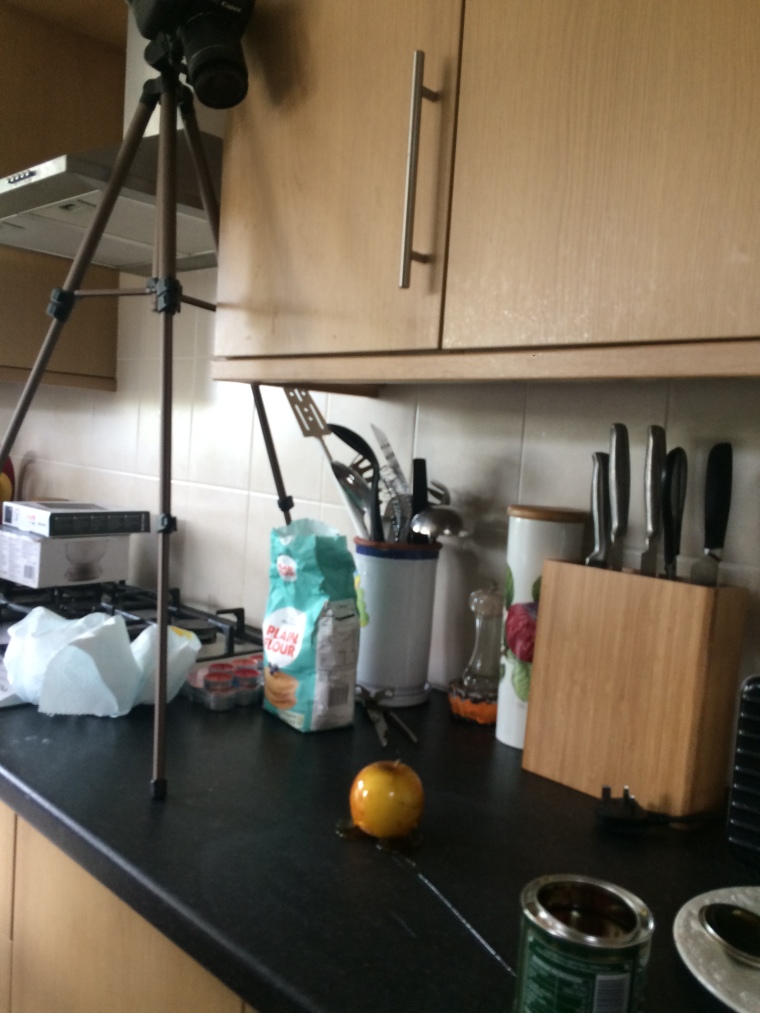
As you can see, the camera is placed on the tripod on my kitchen counter, and it’s at an angle so that it hangs over the object placed on the counter, like a bird-eye-view of the object and it’s interactions. To be able to actually reach the camera controls, I needed to stand on a chair, and that comes with it’s own risk factors. However, I was careful not to fall or knock the tripod in any way that might cause the camera to fall, causing damage to college property or anyone in the room.
The camera being so high up also had good points to counter the bad. For this film I was using several viscous, or liquid components, and I wouldn’t want to accidentally get golden syrup all over the camera. Because the camera was so far up and out of the way, with everything else being so far away from it on the counter, there wasn’t even a chance for anything wet or sticky to get on and damage the camera.
I managed to blow through this poem fairly quickly, which I was pleased with because, as I mentioned before, I was worried about loosing daylight. If there’s one thing that I would change about this filming technique, it would be the surface that I filmed on. I chose the counter because it seemed to me at the time to be the best surface. Also my kitchen has lots of windows which let in a lot of natural light, and if I had decided to film on my dining room table (in a room which has no windows) it would have been low lit and I didn’t want that because it wouldn’t have been as quality work. On the other hand, I didn’t like the black grainy colour for the background of these shots. I was thinking that I could alter the colour in editing, however I think that would be tricky because the counter’s not one solid colour (it’s still worth a try though). I would have preferred the counter to have been a pastel colour, completely on the other end of the colour spectrum to black. If I were to redo this filming (which may be required as I’ve set back a week before half term to film re-shoots) I would use a cloth or fabric of a lighter colour to be able to have a lighter more pastel background. I think I might have to re-shoot this one if I can’t somehow fix the colour of the background in post-production.
The second poem I filmed was Do Not Stand At My Grave And Weep by Mary Elizabeth Frye (analysis of this poem can be found here). For this poem I had a semi-coherent narrative going on about two lovers, one of which dies. For this I used two of my friends I had invited over to be in the film. Here is the shot list I created for this film:
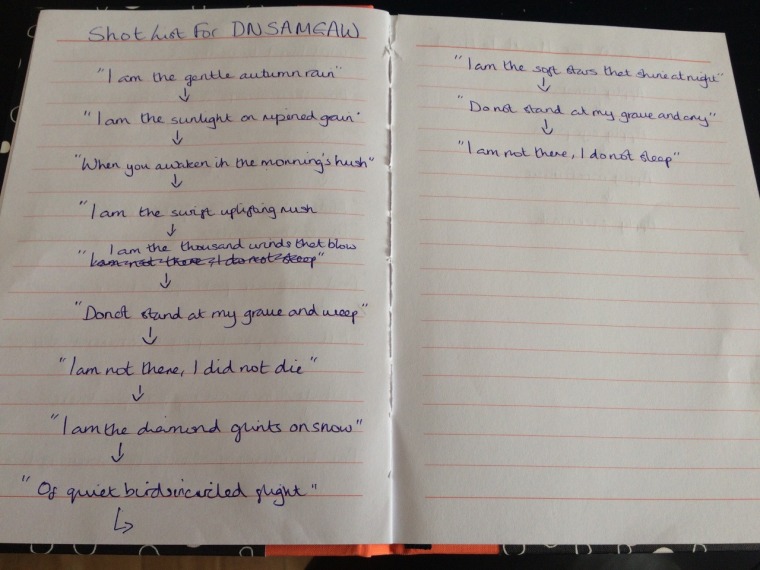
I used lines of the poem to signify which shot I would be filming. I had all the shots written down in a notebook as well as a storyboard, which can both be found here.
This film contained the only shot that meant we would need to stray away from my house for the filming, the rest of the shots could be completed either in my house, in the street just outside (which isn’t at all a busy one), or in my garden. However, we didn’t have to travel far as it was just a two minute walk up to my nearest bus stop. In this shot I wanted to have two people stood at the bus stop, and one would be holding an umbrella, and would step over to the other who was visibly cold and exposed to the weather. This would be symbolising how the two lovers had met.
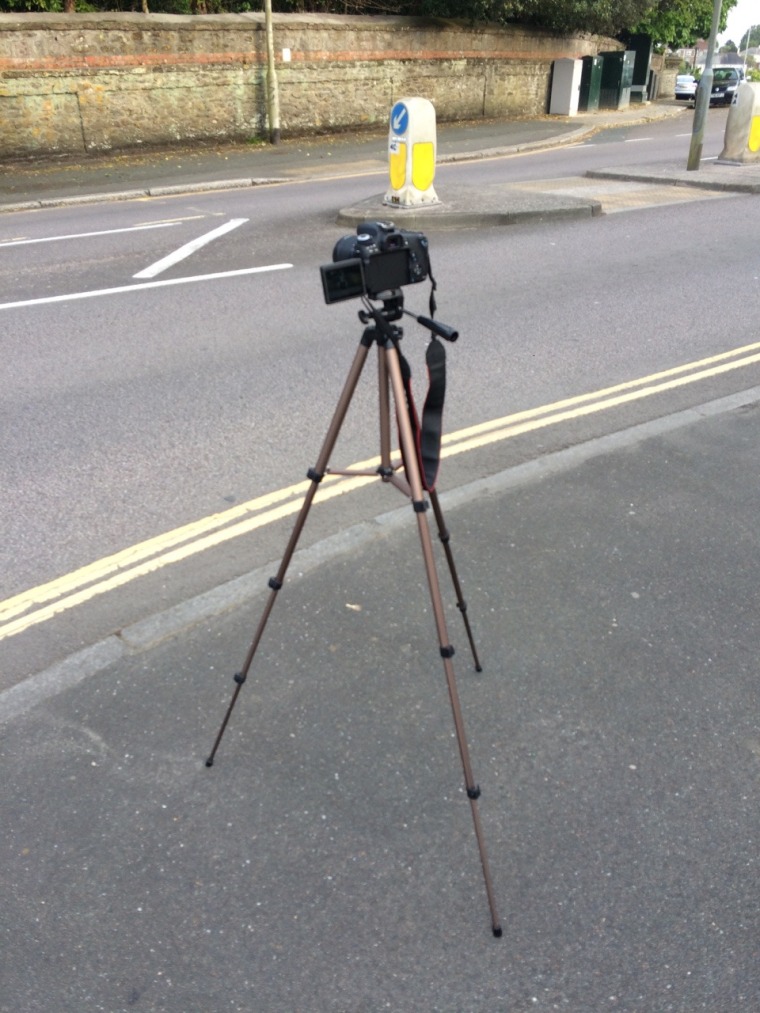
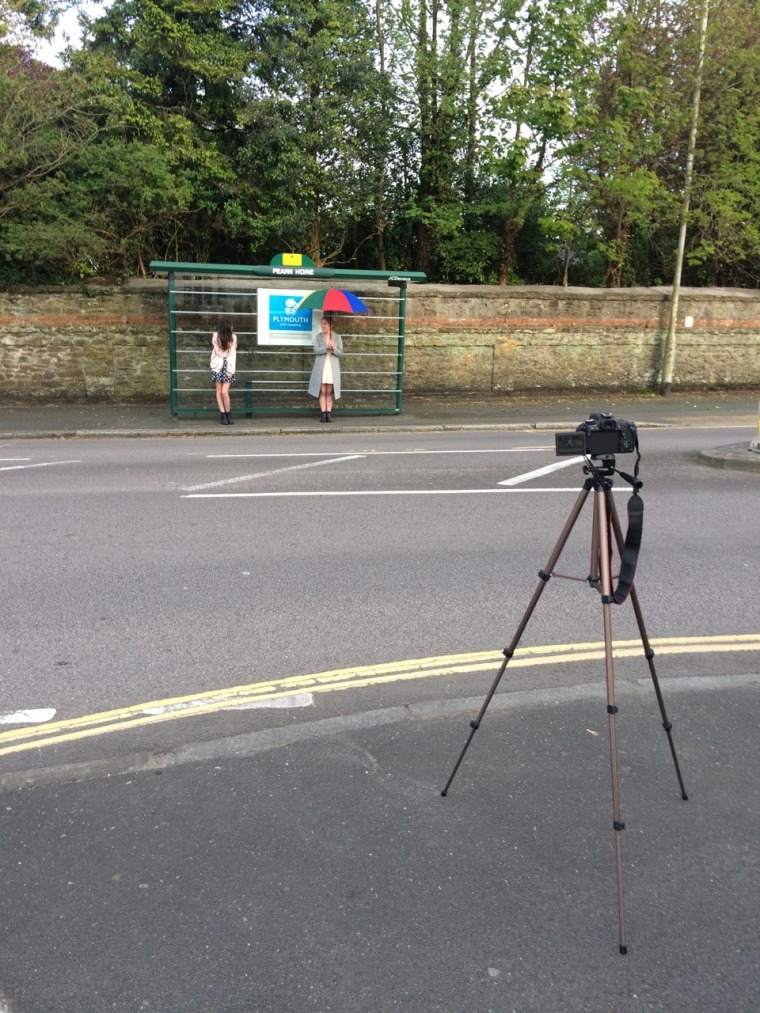
I ordered the shots, in a way that would be most convenient. The first shot being the one where we had to travel the short distance to the bus stop, and then the shots in the garden for DNSAMGAW, then the shots in the house. I knew that I needed to be efficient and film the outside shots that needed daylight first because it was nearing the end of the day and I didn’t want to miss my window of opportunity. I also knew that I needed to film the indoor shots that required natural daylight quickly after the outside ones. The filming for DNSAMGAW went smoothly, although reviewing the footage after the fact I think I’ll try and reshoot some of the footage because there was some that I wasn’t satisfied with.
Next I moved on to film my last poem, which was City Dusk by F. Scott Fitzgerald (analysis of this poem can be found here). Here is the shot list, and the pre-production aspects can be found here.
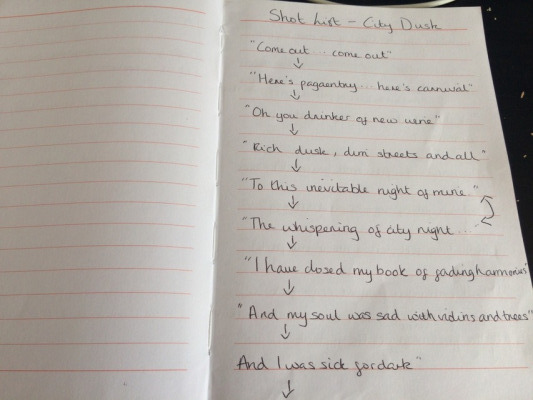
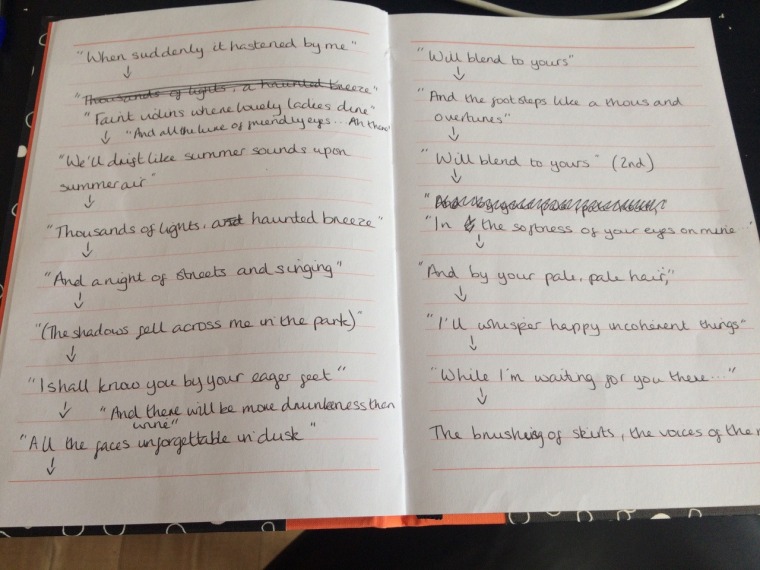
As expected, I needed to film these shots in the dark, so we had a (well needed and deserved) break until it got darker, although it was nearing dusk anyway so we didn’t have to wait long. During this time I reviewed the footage I had and was happy with it, with perhaps a few exceptions that I was confident I could reshoot at a later date without needing my actors. When it did get dark, we all headed out into my street to film the street scenes for City Dusk. Originally, I had wanted to film this on a cobbled street somewhere, so I was thinking about filming at the Barbican. However, I thought it would be too taxing traveling there because although it isn’t far, I wanted to confine the shooting to my house and within walking distance of my house as much as possible equally for efficiency and convenience. Also, I wasn’t too comfortable filming in a semi-unknown place in the dark, so I decided to use my street as, although it isn’t cobble stones, it still satisfied my vision for how the scene would look.
I directed my actors to perform natural movements and interactions with each other as they walked down the street. I’m really pleased with these shots because I think they look very natural and organic, as if the character’s on screen are not acting and don’t actually know I’m behind them following them with a camera. For these shots I used a figrig to stable my shots, although I wanted to have a little camera shake to add to that organic feeling. Originally, I had planned to book out an over camera portable light because I would be filming in the dark, but there weren’t any available for filming, so I had to suffice with using the torch on my iPhone. This wasn’t inherently a bad thing however, because the torch provided ample light for filming in the dark. The only difficulty was me having to hold both the light and the figrig, so it was a little precarious, but because I was using everyone I had on screen, there was no one to help me off screen. Perhaps for the next project, I’ll make sure that along side actors I have someone to help me behind the scenes as well.
After the street shots were done, we moved into my back garden to film some final shots for my City Dusk film. These shots once again required the light but because I didn’t have everyone on screen at once, there were people to help hold the light. I particularly like one set of shots I took where I instructed them to move the light as a filmed a close up of the face, so the light and shadows on the face would dramatically change.
Overall, I’m really pleased with this filming because I managed to get three of my films filmed. I know I’ll have to reshoot some of the footage because on reviewing it I found that I wasn’t completely satisfied with it, but I have plenty of time to be doing that so I’m not worried or stressed about that. I think I worked safely and efficiently, with good time management
Unused Footage
City Dusk
I didn’t use this footage because I was testing out whether I wanted to follow them while they held hands or let them walk away from me holding hands while I stayed stationary. I found that I preferred to follow them so I could keep the focus on the held hands.
Do Not Stand At My Grave And Weep
This footage was quite tricky to get because I was standing on the opposite side of the road, and every so often a car would pass by in the shot, so I had to shoot it quickly in between cars driving from the left and the right. This isn’t the problem with this shot however, I just didn’t like the way Lola (grey coat) moved over to Virginia (blue dress), because instead of taking steps which I later directed her to do, she was taking more of one giant leap which made the whole thing look less natural.
I didn’t use this footage because I didn’t like the way it looked. I just wasn’t satisfied to how the shot was composed, and I didn’t think it looked professional enough. I was fairly happy with all the other shots I shot, save from a few, and I felt like including this shot would take away from the overall look and feel of the piece.
I didn’t use this footage because I couldn’t find a place for it to fit in with my other footage. I’d already filmed a lot of the footage in that garden, so I felt like I didn’t want anymore shots that used that setting, because I didn’t want it to feel too repeated. I was originally planning to have this shot mirror the final shot of the film, having Virginia (blue dress) sit there on her own instead of next to Lola (pink dress) like she would do before, so I was a little reluctant to not use this shot. However, I decided since I didn’t want too many shots in my garden, and I didn’t really like the composition of this one that the end shot on it’s own without the mirroring previously would suffice.
This was the first take of the last shot of the film, however, it was unusable because Virginia looked at the camera whilst walking up the steps to my house, so this was more of an outtake situation than a aesthetics situation. Luckily we managed to get the right shot in the second take.
I didn’t use this footage because I really didn’t like the lighting and composition of the shot. I shot this shot at dusk, when it was beginning to get dark outside. I shot it by bringing my duvet and pillows done into the living room of my house for convenience reasons because filming on my actual bed would be too tricky because it’s right in the corner of the room and I wouldn’t be able to adjust myself and the camera for an overhead shot. However, my living room is painted a cream shade, with brown carpets, so when it gets to dusk if you film or take a picture in there, the end result is a very warm, yellow shot, which wasn’t ideal for this shot. So I decided to scrap this shot entirely and replaced it with footage I shot in Barcelona at a later date.
Heart To Heart
This is the footage that I shot for my first idea for the poem Heart To Heart. Although I ended up not using this footage and switching to another idea, and then ultimately not using this poem in my final film at all, I shot quite a bit of footage for it, so this is a selection of my favourite shots from that filming date. Luckily the filming of this poem didn’t take very long, so it wasn’t a whole lot of time wasted. I just wasn’t satisfied with the footage for this poem, because I thought it looked ugly and unprofessional compared to the other shots for the other two poems I had filmed on the same day.
I think that trying to do four separate films for four different poems was asking way too much of myself, and I overestimated how much time and resilience I would have, and I worked myself too much. After filming three out of four poems on this filming date, I was completely physically and emotionally drained, so after a while of reflecting I decided that I wouldn’t be using The Trembling of the Veil, or Heart To Heart. I knew that if I focused too much on completing all four films, the quality of these films would drop, and I didn’t want to prioritise quantity over quality. I wanted to have a polished and professional end production, and that wasn’t going to happen if I was overworking myself trying to film, essentially, four separate short films, all in the space of about a month. Therefore, I decided to scrap working on the Ginsberg and Dove poems. I did feel sad about this, especially because I’d put so much planning and work into it, but I don’t regret my decision because I would have completely overworked myself. There are still the research posts I did about these two poems on my blog under the tag ‘scratch’ however.
Filming Diary – 23/05/2017
Today I was filming for the fourth poem in my sequence, Heart to Heart. Heart to Heart is a poem written by Rita Dove, detailing her heart in a series of similes and metaphors. The analysis for this poem can be found here.
The idea for this film was inspired by the 2000 film American Psycho. It’s directed by Mary Hannon, and features one scene which I took main inspiration from and payed homage to in this film. The scene details main character Patrick Bateman (played by Christian Bale) tells us the audience over voiceover what his skincare routine is, as on screen he performs this routine.
The shot list for this film can be found below. It was a very short shot list because there were really only four things that I needed to film. I have also done pre-production work, as well as work that was originally planned but later changed or scrapped, which can be found here.
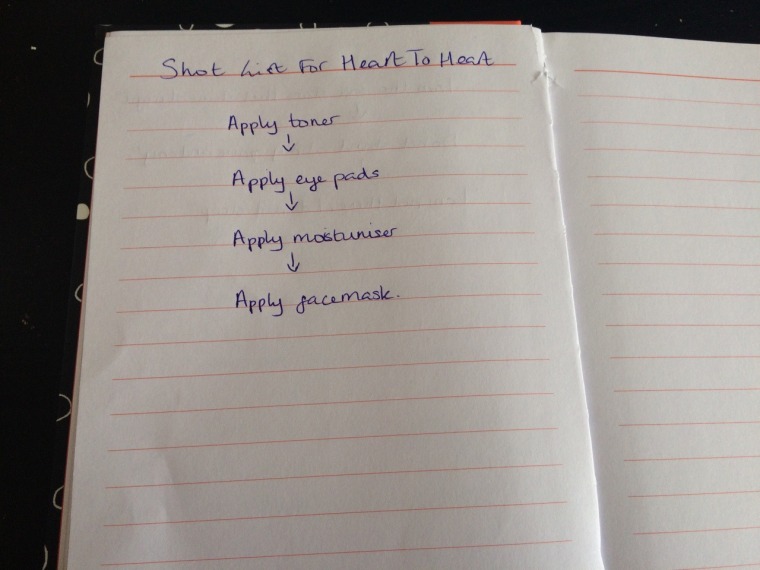
The filming commenced at around 3:30, me and Drew set up the equipment I needed in the lighting studio, which was a camera, a green screen, one light, and a tripod. The previous lunch time I had gone to Boots to purchase some cheap skin care products for this shoot. I ended up buying some moisturiser, a face mask, some facial toner, some face wipes, and some eye makeup remover pads. This came out of my own money but as it only came to about £6.50 I wasn’t too fussed.
I knew I wanted a green screen for this project, which was why I was going to be filming in the lighting studio as opposed to doing my filming outside of college. Originally I had planned to green screen in footage of people walking about, as if he was performing his skin care routine in this middle of a busy street. This I felt contrasted to how personal a skin care routine is, and in turn the symbolism to how personal the feelings in your heart are too. However, I decided that on such limited time I didn’t have the time to do this, as I was originally planning to film people walking across the green screen, and then layer it so it makes it look like there’s lots of people. I instead decided to green screen him so it looks like he’s in a very lavish bathroom, one that someone with considerable income would own.
I filmed him in sections, which amounted to him putting on four skin care items, so four shots. Originally, I was nervous that this wouldn’t be enough footage to last the entire voice over of the poem, but since the poem is quite short (it only looks long because the lines are written short and vertically) that won’t be an issue. First he applied the toner, which I decided to shoot first not only because it will be the first thing he applies in the film, but also because it’s the easiest. After that, I filmed him applying the eye makeup remover pads to his eyes. I know that these are used to remove makeup and aren’t a part of a skincare routine, but I wanted something to look similar to when people in films places cucumbers over their eyes. Obviously I did’t want to actually use cucumbers because that would mean I would have to carry around a cucumber all day, so I thought these eye pads would suffice. The I filmed him putting on moisturiser. This will be the last step in the skin care routine, but I wanted to save the messiest until last. That said messiest was the sheet facial mask. It wasn’t extremely messy it was just very wet and goopy and I didn’t want start with that as it would be the most difficult to apply and would take the most perfecting.
Overall, I think that this shoot went really well and I surprised myself in how quickly and efficiently I was able to turn this shoot around. I went from thinking that I would have to skip out on filming this poem because I had overestimated how much work I could achieve, to being able to film it in about a half hour.
Pre-Production
I created the storyboards and notes for these poem at relatively the same time, because I know that pre-production is vital to having a well conceived film and idea, and an efficient and easy-as-can-be shoot.
With all of my poems I started off by hand writing the poem into a notebook. I found that handwriting the poem and physically writing down the poem and my ideas helped me picture them more clearly in my head as opposed to just typing it all up into a word document. After I had written the poem I read it a few times to gage the meaning and my understanding and what I took from the poem. For some poems, for example Do Not Stand At My Grave And Weep by Mary Elizabeth Frye, I could conceive a proper story with an easy to follow narrative. However, for other, for example The Trembling of the Veil by Allen Ginsberg, I couldn’t so much picture a linear narrative as much as a series of shots that would be up to the viewers interpretation as to what they mean, but they’re all symbolic to what I took away from the poem.
After having an idea, I began to string certain shot ideas to certain lines of the poem, writing them on the next page. With a bright highlighter (so it was easy to see) I connected the shot with the corresponding poem line. Some shots were easier to come up with than others, but eventually I would have a conceptualised idea in my head and on paper of the shots I wanted to film for each poem. There were a lot of shots so I knew I had my work cut out for me, but I knew that I could manage it. I also knew that it was likely that a lot of these shots would end up on the cutting room floor during the editing stages, so I allowed myself the flexibility of not getting too attached to one particular shot that I wouldn’t be able to let go of even if needed be.
After writing these shot ideas into a notebook, I transferred them onto a storyboard. Realistically, I knew that I could manage without a storyboard because of the clear image in my head of each shot I wanted in my film. However, because the notes were made only for my eyes, and they were very messy, I knew I needed to have a story board as well, to make sure that I have a clear representation of what I want in my film. It’s good industry practice, because if I work in a company, I won’t be the only one working on the film, like I am for this project, so all the shots and ideas will need to be clear so that everyone can understand what’s going on and what shots are needed.
Poem #1 – The Trembling of the Veil by Allen Ginsberg
For this poem I wrote notes and created a storyboard. Although I didn’t end up using this poem in my final production for time constraint reasons, I’m still glad I put some practice into the art of storyboarding because, although I personally find it quite tedious, I think it’s a good skill to have, as it’s vital to the film-making process.




Poem #2 – City Dusk by F. Scott Fitzgerald
Again, for this poem I wrote down notes in a notebook regarding my shot ideas, and then created a storyboard. I did end up using these ideas and this poem in my final production, and I found the storyboard vital to my filming and editing process. If I had just had the notes and no storyboard (and also a shot list), I would have found shooting this poem very difficult, as my notes were quite scribbled and messy. And if I couldn’t understand them easily, it would have been practically impossible for someone else who obviously isn’t in my own head swimming around with my own ideas to take on the shooting task. Having the storyboard also helped me in editing, because the shots were not filmed chronologically – as is normal in a filming setting, for efficiency and for convenience – really helped me figure out which shots had to go wear, and when I had to cut them etc. Again, if I hadn’t had the storyboard I would have struggled a lot more, and the editing process would have been a lot longer, maybe doubly so.
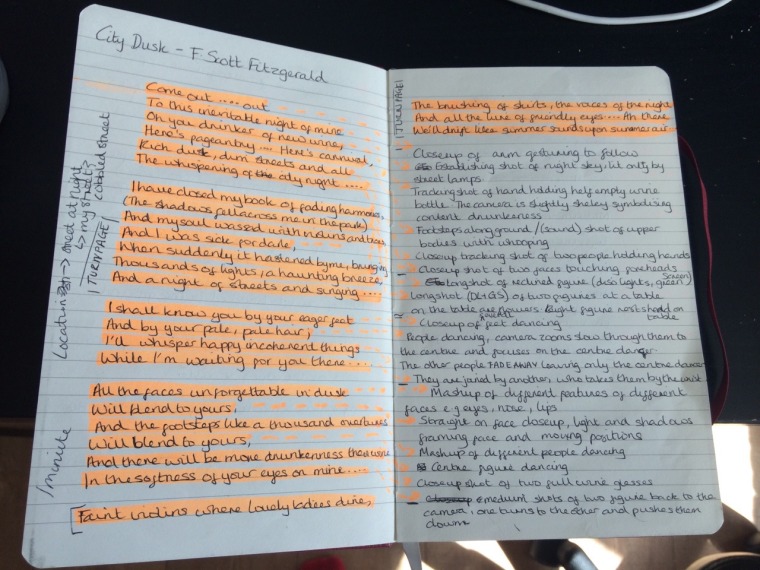
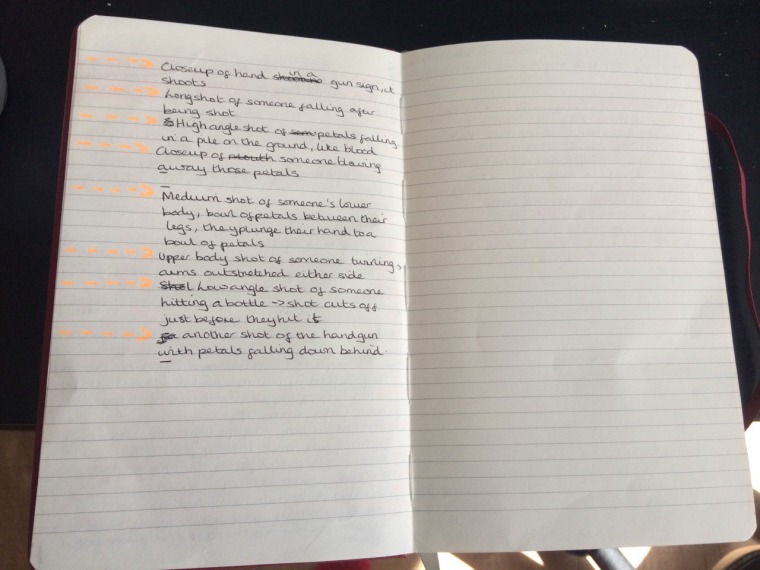
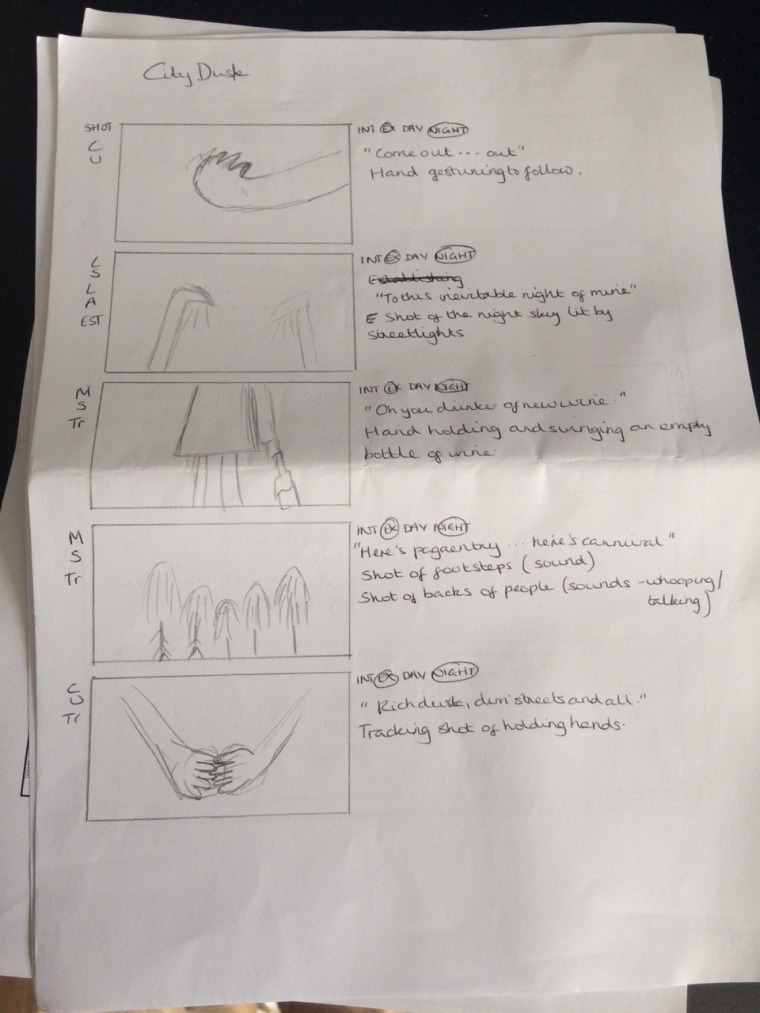
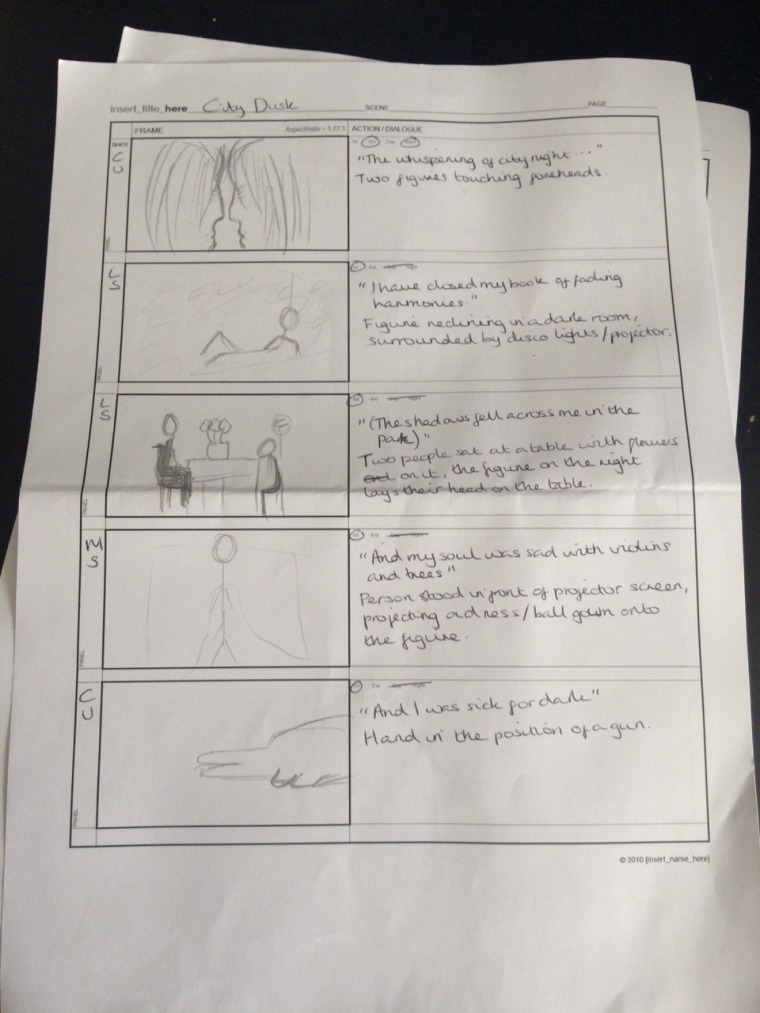
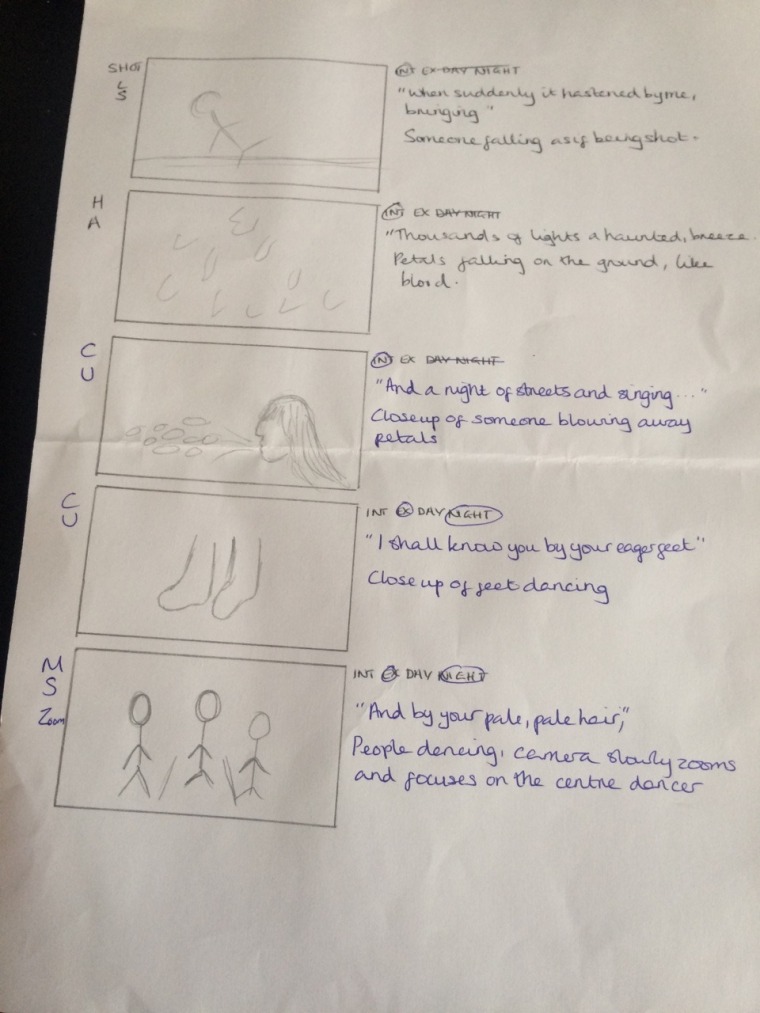
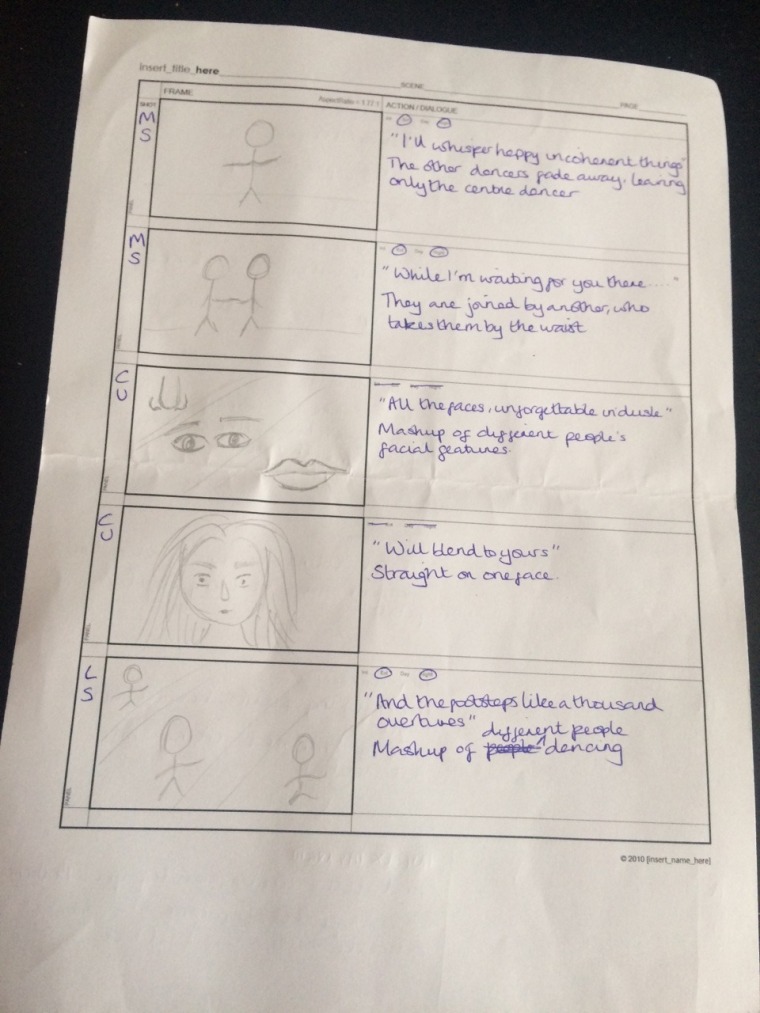
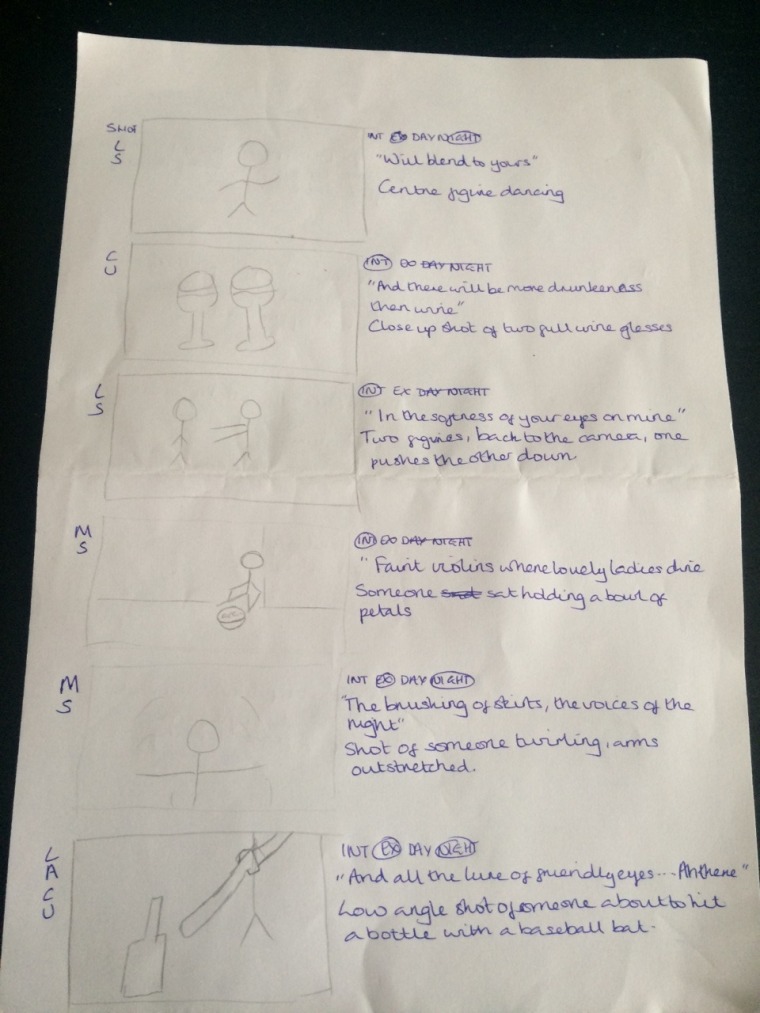
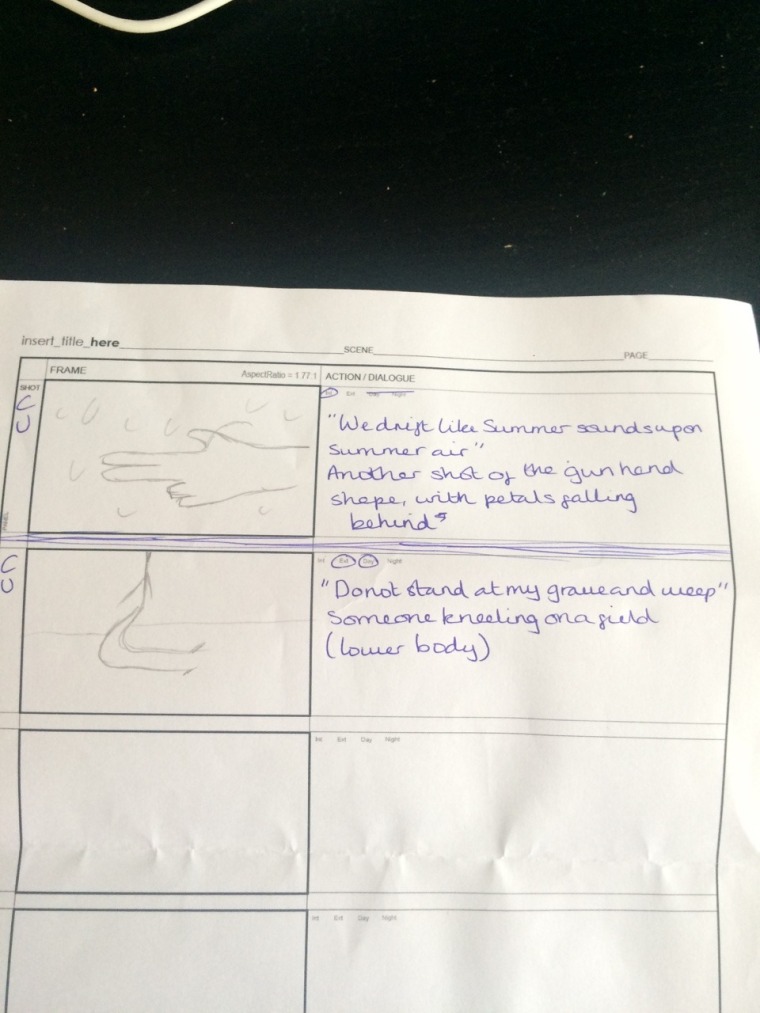
Poem #3 – Do Not Stand At My Grave And Weep by Mary Elizabeth Frye
This was the only poem I shot that I had not written a storyboard for. This was partly down to me having a clear image in my head of what I wanted to shoot. Since this poem has a stronger narrative that’s I’ve created film wise, it was easier for me to be able to string shots together in filming without the aid of a storyboard. However, a lot of the lack of storyboard was down to time management issues. I was originally planning on creating a storyboard after filming, because although I didn’t need one to help me film I thought it would be a good idea to have one to show for pre-production. However, I found that I just didn’t have enough time, so I sacrificed creating a storyboard for this poem to make time for more (in my opinion) pressuring and prioritised aspects of the projects that I still needed to finish – such as important blog posts, film logs, and editing. However, I did write up clear notes for this poem in the same way as the previous two.
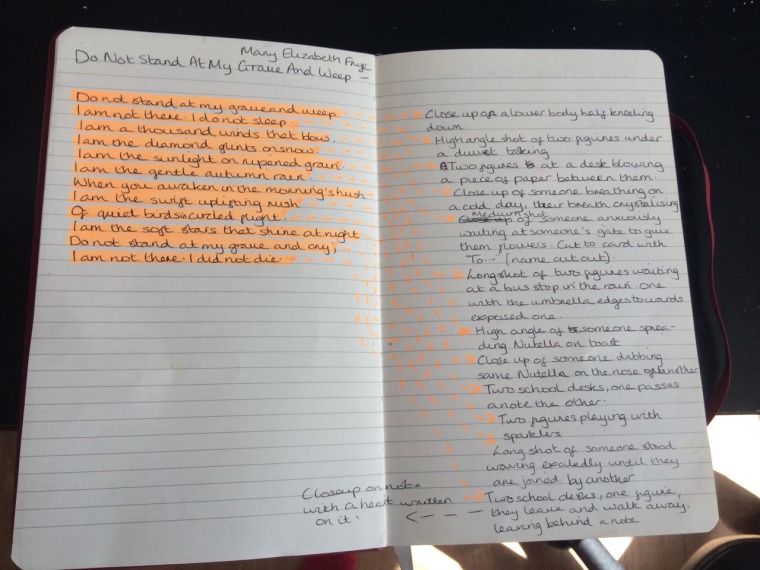
Poem #4 – Heart To Heart by Rita Dove
This poem suffered the same problem as the Frye poem, not enough time. If I were to go back and re do this project, and to keep in mind for the next project, I would make sure I had completed all, if not most of, the storyboarding before the filming dates, to avoid running out of time. However, this poem was quite a simple concept, although it was more complicated as first conceived, but when I changed the idea it was simple enough for me to feel like it didn’t warrant an urgent storyboard and that aspect could be put to the back whilst other important elements of my project were completed. Again, however, I did write down notes for my first idea, but not for my second one as I didn’t have enough time, and the idea was very simple anyway.
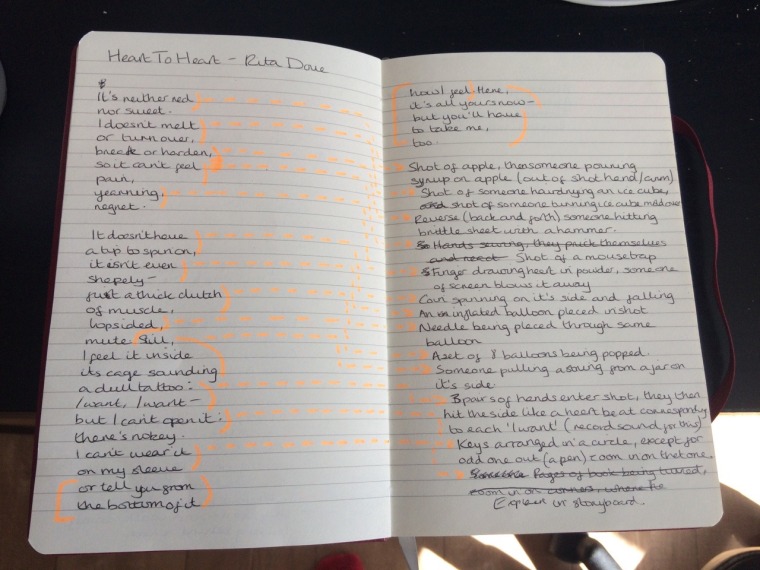
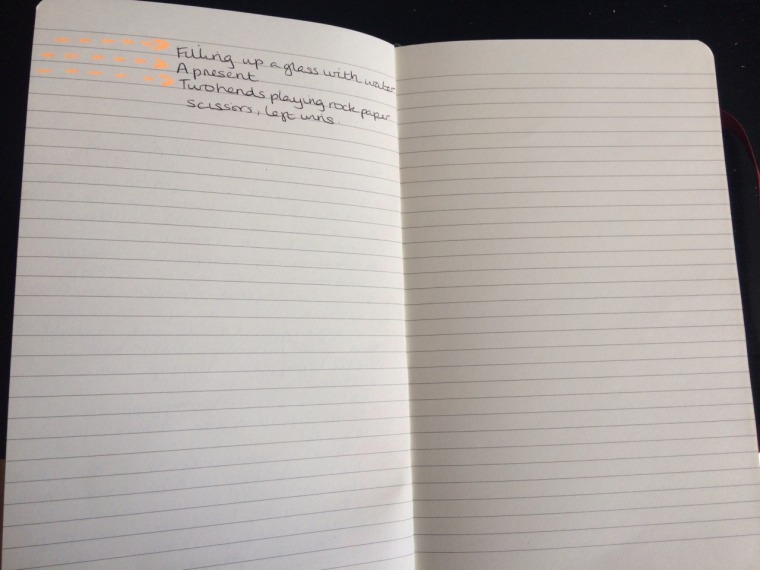
Blog The Week 5
29/05/2017 – 02/06/2017
Monday
This week was half term, and me and my family were departing for a holiday in Barcelona, so I knew that I wasn’t going to be able to get much work done. However, before the holiday I had decided that I was going to film some scenic shots of the city and whatever I found aesthetically pleasing to possibly include in my film. I did this because I was quite anxious that, after combing through and scrutinising my footage for each poem and perhaps deciding to not use some footage, I wouldn’t have enough footage. Ultimately, my aim was to have a piece of footage for each line of the poems, and each piece would correspond with whatever line was being voiced over, in some symbolic fashion. However, upon looking through my footage I found that I wouldn’t have enough footage for each line. I had a choice: either I kept footage I wasn’t happy with in the film so that there would be enough, or I shot new footage. By this point, I knew reshoots were out of the question, because they would take too much time (if I had had a free half term, I’m sure that reshoots would have occured), so I decided that I would take advantage of being in such a beautiful city as Barcelona for the first time, and film some things I found aesthetically pleasing to put in my film. I didn’t know exactly whether this footage was going to be used, but it was reassuring to know that I had extra footage to use if I ever needed it. It turned out that I did end up using almost all of my Barcelona footage so I’m glad I did this.
Tuesday
N/A
Wednesday
N/A
Thursday
Again, today consisted of me occasionally taking out my camera and filming parts of the city that caught my attention that I think would fit into my film. I made sure to only film parts of the city that would fit into either the general narrative or tone of the poem, so that the footage I filmed in Barcelona wouldn’t be very detached and too strong a contrast with the footage shot in England.
Friday
N/A
Do Not Stand At My Grave And Weep
Do Not Stand At My Grave And Weep is a poem written in 1932 by poet Mary Elizabeth Frye. It’s a very famous poem (and Frye’s only surviving work), that most people will know or recognise if mentioned or recited to them. It was scribbled on a plastic bag in a moment of spontaneous inspiration, to comfort a friend of Frye’s who has recently had their mother pass away. Originally, no one knew where the poem originated from, or who wrote it. It was only in 1998 when journalist Abigail Van Buren confirmed it was in fact, after research and investigation, Frye who had penned the poem. The poem is written from the perspective of someone who has passed, talking to a lover, friend, or family member, about how they shouldn’t miss them because they are in fact not dead, and their soul has transferred to watch over them. “I am a thousand winds that blow. I am the diamond glints on snow.”
Do not stand at my grave and weep
I am not there. I do not sleep.
I am a thousand winds that blow.
I am the diamond glints on snow.
I am the sunlight on ripened grain.
I am the gentle autumn rain.
When you awaken in the morning’s hush
I am the swift uplifting rush
Of quiet birds in circled flight.
I am the soft stars that shine at night.
Do not stand at my grave and cry;
I am not there. I did not die.
This poem is very simple, and not particularly filled with extravagant language. It’s a very simple poem for a complicated, yet calming and peaceful, concept – the existence of a human soul after their body has perished. The language used in the poem is very simple and peaceful; soft language used in a poem meant to serve as a reassurance, a shoulder to lay your head on. This is the only poem I’m using which consistently rhymes the whole way throughout. The other three poems either are not rhyming poems, or rhyme inconsistently – some sections rhyming in couplets or otherwise, but overall not having a rhyming rhythm. This poem rhymes predominately in couplets, as in, every two lines rhyming. This serves as a comforting pace to the poem, one with soothes the reader and eases them through a poem that, without rhyme or erratic rhyming patterns, would feel much more bittersweet.
I decided to choose this poem because I really liked the way it flowed, and the imagery it conjures up in the reader’s mind. It’s also a very comforting read, one that makes you feel warm and happy, despite the subject being a loved one lost. This poem was perhaps the easiest to translate into film out of the four, because it has a very clear story behind it which can be transferred from page to the screen and still have the same effect.
Sources
En.wikipedia.org. [2017]. Do Not Stand at My Grave and Weep. [online]. Available at: https://en.wikipedia.org/wiki/Do_Not_Stand_at_My_Grave_and_Weep [Accessed 4 June 2017].
Heart To Heart
Heart to Heart is a poem written by American contemporary poet Rita Dove. The poem’s premise is simple and harkens back to the title; it’s all about the poet’s heart. Dove paints an intricate picture of her own heart for the reader. “It doesn’t have a tip to spin on,”. She uses metaphors and symbolism to describe her heart and how it works, and how the sensations resonating from the clump of muscle in her chest affect her. “it isn’t even shapely— just a thick clutch of muscle, lopsided, mute”.
The way this poem is set out differs from the other poems I have used in this project. It is the shortest of the bunch, although appears to be longer because of the choppy way the lines are set out. The poem consists of two short stanzas, and possesses a very staccato feeling, each line stopping mid sentence and proceeding and finishing in the line below. The language Dove uses can, at first glance, seem quite simple and possibly even a little flat. However, she relies not on entangled words and detailed description with vastly varied language, she instead relies on the use of symbolism, comparing her own heart to various inanimate objects which at first seem to have nothing to do with the human heart, but as the poem continues, every comparison makes more and more sense, like piece fitting together in a jigsaw puzzle.
I decided to use this poem because the other three poems I was using were all classical literature, and I thought that I needed to take a break from that and inject something more modern into the mix. I originally was stuck for ideas on what this poem was to be, but after some research on various poetry websites and databases, I stumbled across this poem, which I instantly fell in love with. I liked how the poem was short and sweet, but also portrayed a clear message and gave me an insight to the poet’s own feelings on love, romance, and desire. I also really liked how this poem managed to take inanimate objects (which shouldn’t be romantic) and turned them into metaphors and symbols for the complicated emotions of love and fondness in the human heart. The poem starts off very matter-of-fact, with the poet stating the similarities in her heart to actions inanimate objects perform, and ends on a very heartfelt, yet quite sad line. “Here, it’s all yours, now— but you’ll have to take me, too.” It’s a line that reads as quite melancholy, as if the poet has come across problems and love-loss in regards to these circumstances before.
Blog the Week 3
15/05/2017 – 20/05/2017
Monday
Although I wasn’t in college today, I still continued with my work at home. Today I was still planning what I would be doing for my Heart to Heart poem sequence. I also took at look at the Roger Deakins website, the website dedicated to the famous Torquay cinematographer.
Tuesday
Today I completed my music research post for the poem The Trembling of the Veil by Allen Ginsberg. I also decided today that I wasn’t going to compose my own music for my films. I think I underestimated how much work that would be. For the previous project in which we had to create a short film entirely directed by eight year old kids, I took on the task of composing the music for the film. This turned out to be a much harder task than anticipated, and I ended up composing one track instead of four that I was originally planning. Professional film score composers have a much longer time to compose full albums for films, and of course they don’t have to do everything else in terms of production either – storyboarding, scripting, cinematography, directing etc. Therefore I decided that it was just too much to expect myself to be able to compose the music for the film. I’ve already set myself a tonne of work so that I can be as thorough in my research as possible, so to add composing four music tracks would just be far too much. I’d rather focus more on getting a really in depth, polished project than to waste all my time on music and have other parts of my project fall short. Instead of composing my own music, I’m going to be using music from the website FreeMusicArchive, which is a website where independent music artists put up their tracks for free download. While not all of these tracks can be used in video, there are good portion that only require no commercial use, and a handful of tracks that just require credit to the original composer.
I also started to research inspirations for the music of my third poem, Do Not Stand At My Grave And Weep by Mary Elizabeth Frye. I decided to use the music of Moonlight and [insert other inspiration here] as my inspiration for this film.
After completing this I began to research which music from FreeMusicArchive I wanted to use. I wanted to use music from this site because I can get quality music in a wide range of styles, all for free, and all I need to do is make sure I’m not making any money from the video I’m using the music in, and I credit the artist. It’s a huge database of music that’s easily accessible.
Wednesday
Today I continued to plan what I would do for the film of my fourth and final poem, Heart to Heart by Rita Dove. Originally, I had planned to do overhead shots with different objects being interacted with that tied in with similies and metaphors Dove uses to describe her heart in the poem. However, I ultimately decided that I was satisfied with the idea or quality of the filming I had down, I just decided to scrap the whole idea. I kept the footage however, because it’s handy to keep it around, I never know when I might need it.
My second idea came to me while I was doing my makeup in the morning. I suddenly started to think about the famous scene in American Psycho (dir. Mary Harron) where the main character Patrick Bateman (played by Christian Bale) does his skincare routine, going into great detail about what his routine is and what products he uses. I think that scene is very interesting, and also subverts some stereotypes as to how men are portrayed as not being supposed to care about wearing makeup or moisturising and taking care of their skin. I decided that I would emulate this scene, because I knew that I could tie it into the theme of Heart to Heart. The skin is a metaphor for the heart, and the careful routine that taking care of your skin is a metaphor for how the poet takes care of her heart.
Thursday
N/A
Friday
N/A







